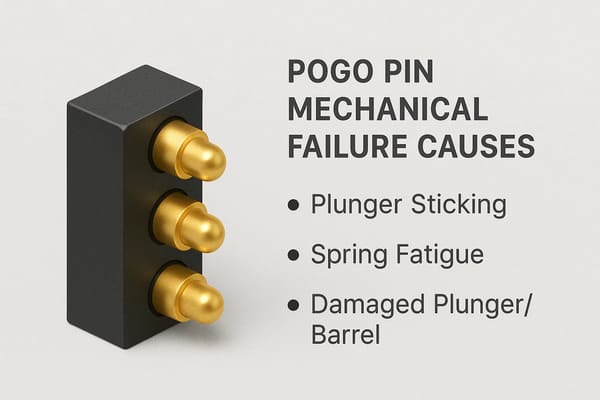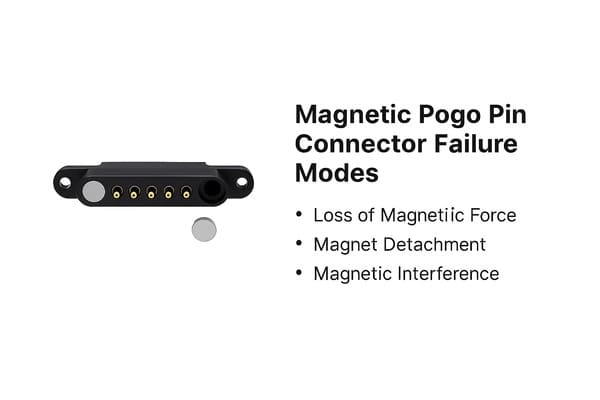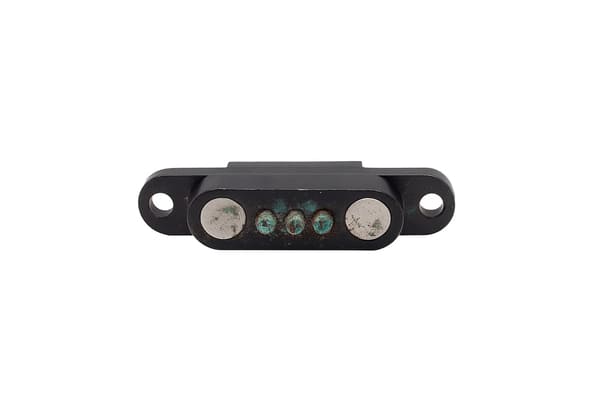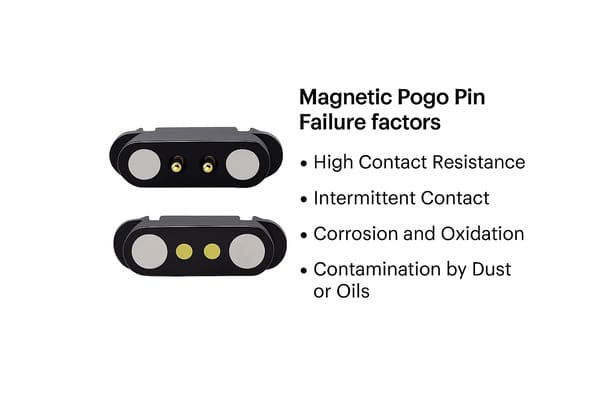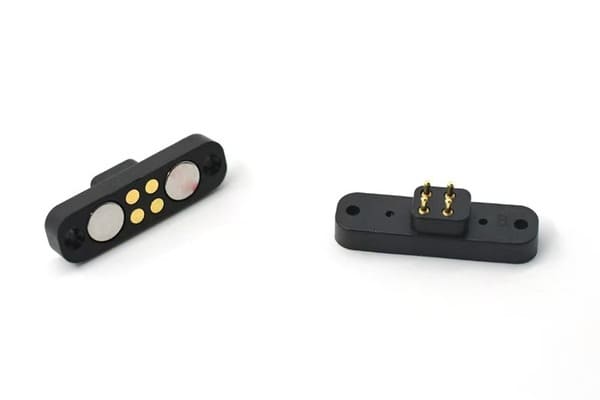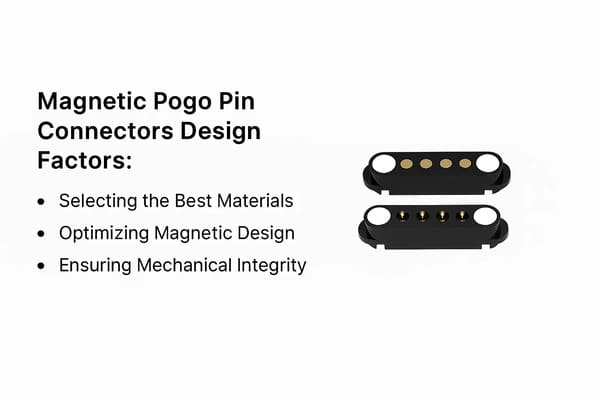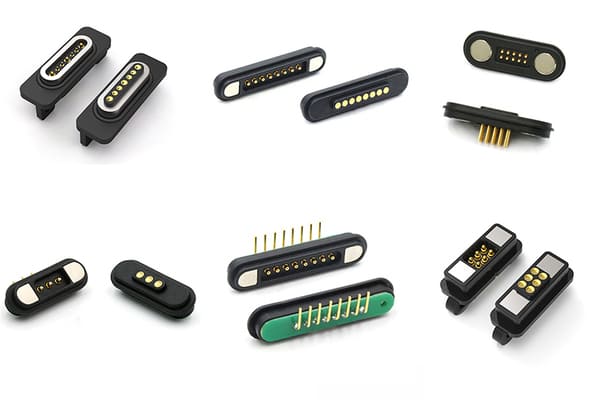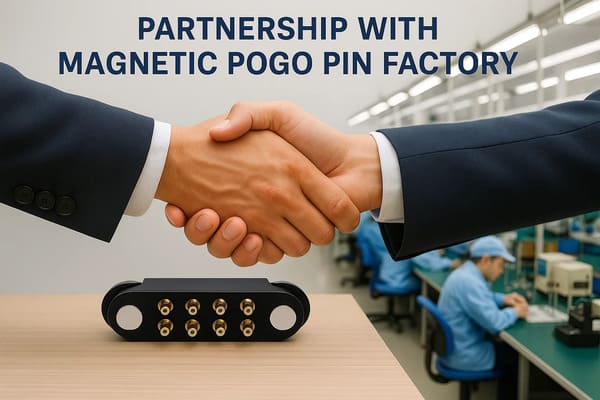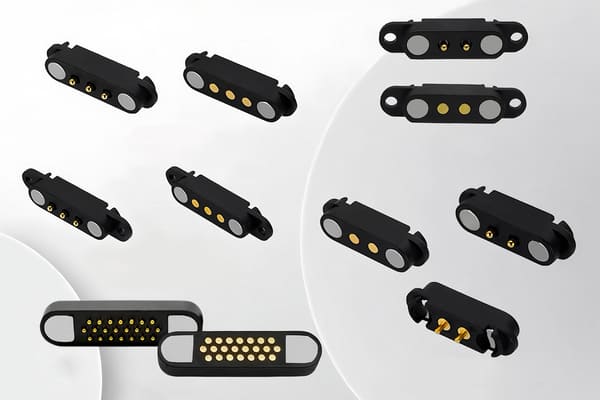Have you ever experienced a device losing its connection at a critical moment?
This frustration often points to a small but vital component: the magnetic pogo pin. These failures can halt charging or data transfer, causing significant operational disruptions.
Magnetic pogo pin failures commonly arise from mechanical wear, electrical interruptions, and environmental factors like corrosion.
Specifically, issues such as spring fatigue, contact contamination, and material degradation frequently lead to malfunctions.
Solutions involve selecting durable materials, optimizing spring design, and applying protective coatings to enhance reliability and lifespan.
Understanding the root causes of these failures is the first step toward prevention.
I will now share more practical insights to help you secure reliable performance in your magnetic pogo pin applications.
How Can You Understand Pogo Pin Failure Modes Beyond the Basics?
Struggling with unexpected device failures that compromise your product’s reliability?
The root cause is often hidden within the mechanical integrity of its pogo pins.
These tiny components are subjected to significant stress during daily use.
Beyond basic issues, pogo pin failures involve nuanced mechanical, electrical, and environmental factors.
Key modes include plunger sticking due to contamination, spring fatigue from material degradation, and high contact resistance caused by oxidation or wear.
Understanding these deep-seated issues, such as uneven current distribution or thermal expansion, requires analyzing design, material properties, and environmental stressors.
These insights are crucial for preventing costly product malfunctions.
Why is this so important?
Let’s break down the details to see how these factors impact performance and what you can do about it.
Mechanical Wear and Tear in Pogo Pins
Mechanical stress is a primary cause of pogo pin failure, affecting both performance and lifespan.
Even minor issues like misalignment or contamination can lead to significant problems, undermining the reliability of the entire device.
- Plunger Sticking: Contamination from dust or debris can cause the plunger to bind within the barrel.
Poor alignment during mating also creates excessive side force, leading to friction and inconsistent spring-loaded mechanism movement. - Spring Fatigue: Exceeding the designed compression travel is a common mistake that permanently weakens the spring.
Exposure to extreme temperatures or using incorrect spring materials for the application also accelerates fatigue and potential breakage. - Damaged Plunger/Barrel: Inaccurate alignment of the mating pogo pin connector can easily cause physical damage.
A poor mechanical housing design or accidental impacts during assembly can bend or dent the plunger and barrel, compromising the connection.
Ultimately, robust mechanical design is non-negotiable for dependable performance.
An innovative pogo pin manufacturer will focus on precise tolerances and durable materials to prevent these common yet critical mechanical failures.
What Are the Unique Failure Modes of Magnetic Pogo Pin Connectors?
Are your magnetic connectors losing their grip or causing interference?
Magnetic pogo pin connectors introduce unique challenges that go beyond standard mechanical issues.
The magnet itself can become the source of unexpected failures.
Unique failure modes of magnetic pogo pin connectors often relate to their magnetic components.
These include loss of magnetic force due to thermal degradation, detachment of the magnet from its housing, and electromagnetic interference with adjacent sensitive electronics.
Suppliers with expertise in magnetic connector design can offer solutions to effectively mitigate these specific risks.
These magnetic-specific problems can silently sabotage your product’s functionality.
Understanding why this happens will transform how you approach your magnetic pogo pin connector design and sourcing.
Let’s explore these further.
Magnetic Component Failures
The magnet is central to a magnetic spring loaded pin’s function, but it can also be a point of failure.
Issues can range from a weakened pull force to complete detachment, affecting connection stability.
- Loss of Magnetic Force: Exposing a connector to temperatures above the magnet’s Curie point can cause permanent demagnetization.
Low-quality magnets may have unstable properties, while poor design can lead to magnetic field leakage over time. - Magnet Detachment: Using an improper adhesive is a primary reason magnets detach from the housing.
Repeated impacts or even thermal expansion cycles can stress the bond, causing it to loosen and ultimately fail. - Magnetic Interference: A poorly designed magnetic pogo pin connection can allow its field to interfere with sensitive components.
Using excessively strong magnets or incorrect pole arrangements can disrupt sensors or other nearby electronics, causing malfunction.
Experience shows that the quality of both the magnet and its integration is key.
A premier magnetic pogo pin factory will ensure that the magnetic design is robust enough to prevent these common points of failure.
Which Electrical and Environmental Factors Cause Magnetic Pogo Pin Failures?
Is your device suffering from an unstable connection or sudden power loss?
These problems often point to electrical or environmental factors that degrade the performance of your magnetic pogo pin contact over time.
They are silent killers.
Electrical and environmental factors causing magnetic pogo pin failures include high contact resistance, intermittent connections, corrosion, and contamination.
These issues stem from factors such as worn plating, exposure to humidity, and trapped debris.
Addressing these variables through proper material selection and custom design is essential.
Paying attention to these details can make or break your product’s long-term success.
Let’s delve into how these failures occur and what preventative measures can be taken to ensure a reliable connection.
Electrical Failures Affecting Magnetic Pogo Pin Performance
A stable electrical connection is the core function of any magnetic pogo pin.
However, various factors can compromise this connection, leading to intermittent performance or complete failure, which can frustrate end-users and damage your brand’s reputation.
- High Contact Resistance: Frequent mating cycles can wear out the connector’s plating, increasing resistance.
Contamination from the environment creates a resistive layer, while insufficient spring force may fail to establish a stable electrical path. - Intermittent Contact: An inconsistent magnetic force may not hold the connectors together firmly enough to prevent momentary disconnections.
Vibration and shock can cause intermittent contact, as can a plunger sticking due to internal debris.
Ensuring a clean, stable, and low-resistance path is critical for every design.
A precision-made magnetic pogo pin can be designed with superior materials and spring force to maintain signal integrity throughout its intended lifespan.
Environmental Factors Impacting Magnetic Pogo Pin Reliability
The environment where a device operates plays a huge role in its reliability.
Factors like humidity, dust, and chemical exposure can severely impact the longevity and performance of magnetic spring probes and their connections.
- Corrosion and Oxidation: Using a magnetic pogo pin in humid or salty environments without a proper IP rating invites corrosion.
Chemical exposure can also degrade the connector’s plating, while improper material choices lead to rapid oxidation. - Contamination by Dust or Oils: The magnetic force itself can attract and trap microscopic debris, which can compromise conductivity.
Industrial oils or greases can create an insulating layer on the contact surfaces, impeding the electrical connection.
A robust design anticipates these environmental challenges from the start.
A top magnetic pogo pin supplier will recommend appropriate IP ratings and materials to ensure your connector withstands its intended operational environment reliably.
How Can Strategic Solutions Prevent Magnetic Pogo Pin Failures?
Preventing failures in magnetic pogo pin connectors requires a proactive approach focused on strategic design and material selection.
Rather than reacting to failures after a product is launched, the key is to build reliability in from the start.
Preventing magnetic pogo pin failures involves focusing on selecting high-quality materials and optimizing magnetic designs.
It also requires ensuring robust mechanical integrity.
Collaboration on a custom design addressing specific application needs helps ensure long-term reliability and performance.
This proactive approach is the key to building a successful product.
Why is partnering with the right expert so crucial for your project?
Let’s explore how a specialist adds value and prevents issues.
Design and Selection Solutions
A well-designed magnetic pogo pin is the foundation of a reliable product.
Smart choices in materials, magnetic configuration, and mechanical structure can prevent the most common failures before they ever occur, saving time and money.
- Selecting the Best Materials: Prioritizing corrosion-resistant platings like gold is essential for longevity.
Specifying high-endurance springs ensures they withstand millions of cycles, while using high-grade magnets provides a stable and consistent connection force. - Optimizing Magnetic Design: Proper magnetic pole configuration is crucial for creating a secure, self-aligning connection.
The housing design must protect the magnets from impact, and the overall design should mitigate any potential interference with sensitive electronics. - Ensuring Mechanical Integrity: Incorporating guide pins or asymmetrical shapes ensures correct alignment and prevents damage during mating. Specifying the correct travel distance and a high-quality lubricant for the plunger ensures smooth, reliable movement every time.
These design considerations are not just details; they are critical to your product’s success.
An experienced magnetic pogo pin supplier can guide you through these choices to create a truly dependable connection solution.
Why Does a Reliable Magnetic Pogo Pin Supplier Matter for Your Project?
Are you concerned that your current supplier doesn’t understand your project’s unique challenges?
Partnering with just any supplier can lead to quality issues and delays.
Selecting an expert is crucial for avoiding costly mistakes and ensuring success.
A reliable magnetic pogo pin connector provider offers deep expertise in custom solutions, strict adherence to quality standards, and design insights.
This collaboration ensures long-term reliability and performance, ultimately leading to significant cost savings.
They should also prioritize optimal materials and magnetic design.
These benefits directly translate into a more reliable product and a stronger market position.
Let’s break down why this partnership is one of the most important decisions you will make for your project.
The Value of Partnering with a Specialist
Choosing a generic supplier often leads to generic results.
A specialist magnetic pogo pin factory, however, brings invaluable expertise that elevates your product, offering tailored solutions that a generalist cannot match.
- Expertise in Custom Solutions: A specialist can engineer custom magnetic pogo pin connector designs for unique B2B applications.
They work with you to develop prototypes rapidly and provide deep technical support throughout the entire project lifecycle. - Adherence to Quality Standards: Based on industry experience, strict quality control is non-negotiable.
This includes rigorous performance and durability testing in-house, ensuring full material traceability, and offering certified products for highly regulated industries. - Long-Term Cost Savings: A high-quality custom pogo pin design significantly reduces costly product returns and field failures.
This not only extends the lifespan of your device but also minimizes maintenance efforts and enhances your brand’s reputation.
Ultimately, this partnership safeguards your investment and reputation.
An expert turns potential problems into innovative solutions, ensuring your product not only works but excels in its market, providing a clear competitive advantage.
Conclusion
Choosing the right magnetic pogo pin and supplier is critical to preventing failures and ensuring product reliability.
By focusing on quality materials, robust design, and expert collaboration, you can avoid common issues and deliver a superior user experience.
At CTP, we are committed to providing these high-quality, custom solutions.
Explore our capabilities on our homepage or reach out through our contact page to discuss your project’s specific needs with our team.


